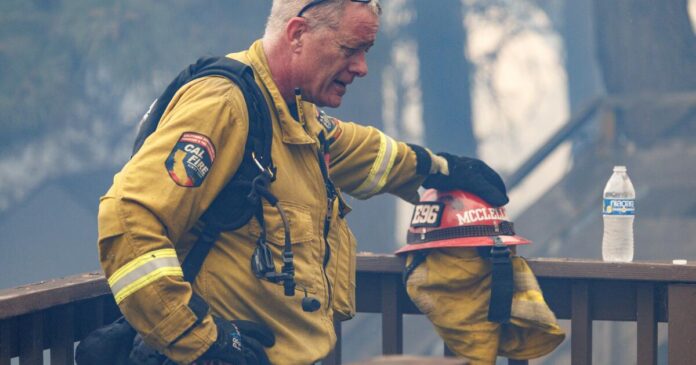
Firefighters battling wildfires burning in Southern California are stretched thin amid a nationwide shortage of firefighters, aircraft and contractors.
Three wildfires have burned homes and scorched more than 100,000 acres in the San Bernardino Mountains, Angeles National Forest and Santa Ana Mountains in several days.
Several firefighters have been hurt battling the Airport fire, which has charred 22,910 acres in Orange and Riverside counties and the Line fire which has burned more than 34,700 acres in San Bernardino County.
More than 3,100 fire personnel and 22 helicopters were assigned to the Line fire on Wednesday. At the same time, more than 629 fire personnel, including seven helicopters, were fighting the Airport fire, according to Cal Fire.
On Wednesday, more than 400 personnel, seven helicopters and four large air tankers were assigned to the Bridge fire, said Lisa Cox, a spokesperson for the California Interagency Complex Incident Management Team.
“Resources are really strapped,” Cox said.
Oregon, Idaho and Washington are also dealing with hundreds of fires resulting from multiple weeks of dry lightning strikes on parched vegetation.
Chris Cline, division chief with the Oregon Department of Forestry, painted a stark picture of crews strained by nationwide resource shortages resulting from what he described as “an epic and record-setting fire season.”
“Nationally, there are no caterers left to support our fire teams — zero caterers available today,” Cline said Monday. “There are no shower units available today.” That’s left firefighters toiling in poison oak with no way to get clean, he said. Fire cache items — supplies like hoses and sleeping bags — are limited, he said.
“There are no incident management teams available in the United States of America today,” Cline said, referring to the groups of personnel who are dispatched to oversee complex emergencies like large fires.
California is facing similar challenges.
“Yes, there is a strain on resources,” said Adrienne Freeman, a spokesperson for the U.S. Forest Service. “We had multiple fires start in close succession all with critical numbers of affected people in huge urban centers.”
The National Interagency Fire Center has set the current national preparedness level to 5 — the highest possible — indicating that federal resources are fully committed and the potential for significant wildland fires to emerge is expected to remain high across multiple geographic areas. That level has been reached this early in the year only four times in the last two decades, according to the agency.
Still, Cal Fire spokesperson Robert Foxworthy said that fire crews are currently managing with the resources they have and that the year has not yet reached the level of 2020, when more than 4.3 million acres burned across California. However, they are preparing for a potentially active season ahead.
“The three fires that we have going are large and taking on a lot of resources, but this is not at all the worst that California has experienced and we’ve dealt with much larger, busier fire seasons in the past,” he said. “So I feel very confident that we’re going to be able to meet the need as we move into the fall.”
Gov. Gavin Newsom announced Wednesday that the state had secured a grant from the Federal Emergency Management Agency to help provide resources to Riverside County to assist with the costs of suppressing the Airport fire.
“California is continuing to see extreme fire behavior across multiple locations in Southern California, where hot, dry weather has led to rapid fire growth,” Newsom said. “We are thankful for federal support from the Biden-Harris Administration to support firefighters as they work to suppress these fires and keep people safe.”



